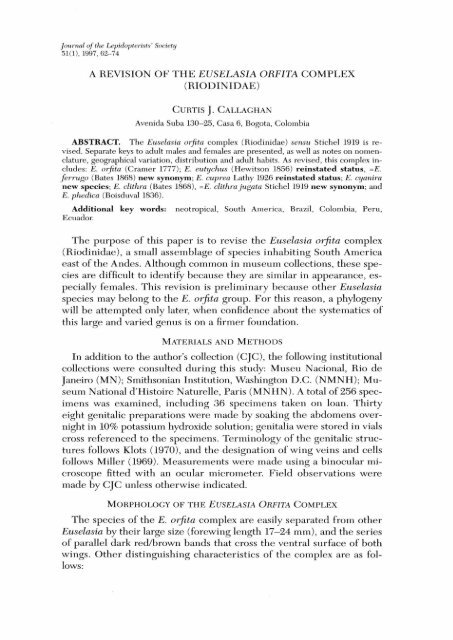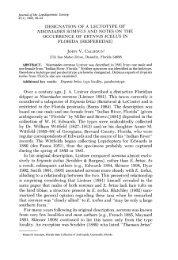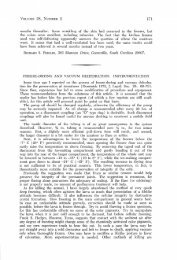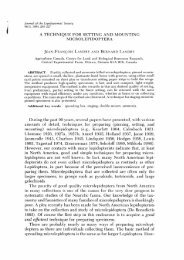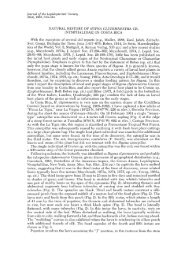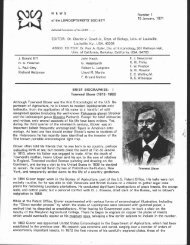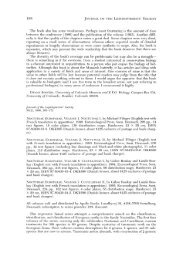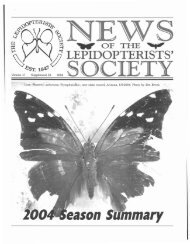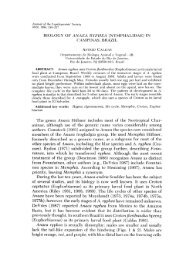A REVISION OF THE EUSELASIA ORFITA COMPLEX (RIODINIDAE ...
A REVISION OF THE EUSELASIA ORFITA COMPLEX (RIODINIDAE ...
A REVISION OF THE EUSELASIA ORFITA COMPLEX (RIODINIDAE ...
You also want an ePaper? Increase the reach of your titles
YUMPU automatically turns print PDFs into web optimized ePapers that Google loves.
journal of the Lepidopterists' Sod ety<br />
51(1). 1997. 62- 74<br />
A <strong>REVISION</strong> <strong>OF</strong> <strong>THE</strong> <strong>EUSELASIA</strong> <strong>ORFITA</strong> <strong>COMPLEX</strong><br />
(<strong>RIODINIDAE</strong>)<br />
CURTIS J. CALLAGHAN<br />
Avenida Suba 130-25, Casa 6. Bogota, Colombia<br />
ABSTRACT. The Euse/asia orfita complex (Riodinidae) sensu Sticbel 1919 is revised.<br />
Separate keys to adult males and females are presented, as well as notes on nomenclature,<br />
geograpbical variation. distribution and adult habits. As revised, this complex includes:<br />
E. orfita (Cramer 1777); E. eutychus (Hewitson 1856) reinstated status, =E.<br />
ferrugo (Bates 1868) new synonym.; E. cupr.ea Lathy 1926 reinstated status; E. cyanim<br />
new species; E. clithm (Bates 1868), =E. clithm jugata Stichel 1919 new synonym.; and<br />
E. phedica (Boisduval 1836).<br />
Additional key words: neotropical, South America, Brazil, Colombia, Pe ru,<br />
Ecuador.<br />
The purpose of this paper is to revise the Euselasia orfita complex<br />
(Riodinidae), a small asse mblage of specie s inhabiting South America<br />
east of the Andes. Although common in museum collections, the se species<br />
are difficult to identify because they are similar in appearance, especially<br />
females. This revision is preliminary because other Euselasia<br />
species may belong to the E. orjita group. For this reason, a phyloge ny<br />
will be atte mpted only later, when confidence about the syste matics of<br />
this large and varied genus is on a firmer foundation.<br />
MATERIALS AND METHODS<br />
In addition to the author's collection (CJC), the following institutional<br />
collections were consulted during this study: Museu Nacional, Rio de<br />
Janeiro (MN); Smithsonian Institution, Washington D .C. (NMNH); Museum<br />
National d'Histoire Naturelle, Paris (MNHN). A total of256 specime<br />
ns was examined, including 36 specime ns take n on loan. Thirty<br />
eight ge nitalic preparations were made by soaking the abdomens overnight<br />
in 10% potassium hydroxide solution; ge nitalia we re stored in vials<br />
cross refe re nced to the specimens. Te rminology of the ge nitalic structures<br />
follows Klots (1970), and the de signation of wing veins and cells<br />
follows Miller (1969). Measure ments were made using a binocular microscope<br />
fitted with an ocular micrometer. Field observations were<br />
made by CJC unlcss othe rwise indicated.<br />
MORPHOLOGY <strong>OF</strong> <strong>THE</strong> <strong>EUSELASIA</strong> <strong>ORFITA</strong> <strong>COMPLEX</strong><br />
The species of the E. orfita comple x are easily separated from othe r<br />
Euselasia by their large size (forewing length 17-24 mm), and the series<br />
of parallel dark red/brown bands that cross the ventral surface of both<br />
wings. Othe r distinguishing characte ristics of the comple x are as follows:
64 JOURNAL <strong>OF</strong> <strong>THE</strong> LEPIDOPTERISTS' SOCIETY<br />
and the pattern consists of a wide >3 mm band beginning at the costa above the cell, that<br />
curves around the end of the cell and te rminates at the inner margin, and with darker<br />
blue-violet between the band and the base; the distal area lacks iredescent scaling (Fig.<br />
9). In the third, there is a thin band 1 mm wide beginning at the base that continues along<br />
the margin to distad of the cell, and then crosses the wing as a 2 mm wide band to the inner<br />
margin, with dark blue scaling on both forewing and hindwing separated from the<br />
thin band by a black area (Fig. 21).<br />
The pattern on the hindwing likewise consists of three types: a deep purple tone in the<br />
distal half (Fig. 1): a marginal band of light blue scales (Fig. 9); or a white Iimbal area with<br />
a glossy light blue sheen (Fig. 25).<br />
Ventral wing pattern. The E. orfita group is characterized by a ventral forewing pattern<br />
that includes six bands crossing the forewing from the costal margin to 2A, and the<br />
hindwing from the costa to the inner margin. These are numbered 1-6 from the base to<br />
the submargin in Fig. 2. Bands 1-4 are reddish brown and band] is thinner and shorter.<br />
The first three bands are slightly convergent toward the forewing costa. Band 5 is broken<br />
into a series of figures consisting of spots and lines, and band 6 follows the margin of both<br />
wings as a distinct band or shading. The bands are the principal means of associating the<br />
sexes.<br />
On the forewing, the shape of band 4 may be straight (Fig. 10) or S-shaped (Fig. 6) in<br />
both sexes. Band 5 begins as three arrow-shaped spots in cells R3-R4' Re M 1, and M c M 2 ,<br />
followed by a wide band between M .l and 2A on the inner margin. The band between M3<br />
and 2A has three types: a straight heavy line to 2A, veering basad to the inner margin as a<br />
thin projection (Fig. 2); a band curved towards the costa, uniting with band 4 at M3 (Fig.<br />
6); straight as above, hut not reaching below 2A (Fig. ]0).<br />
The ventral hindwing is characterized by the continuation of bands 1-4 from the<br />
forewing. Band 5 becomes a series of arrowhead-shaped spots pointing basad between<br />
the veins, with a blue ocellus in cell M2-M3, bordered on three sides with orange and distad<br />
by white. The distance between the ocellus of the hindwing ventral surface and band<br />
3 differs significantly between species, and is greater in females.<br />
Genitalia. The male genitalia (Figs. 29-34) are simple with a broad bilobed uncus<br />
Widely separated from the tegumen, the latter with two narrow falces and joined to the<br />
valvae by a long, thin vinculum. The saccus consists of a widening of the base of the vinculum.<br />
The valvae are elongate, spatula-shaped with Rat tips and a heavily sclerotized process<br />
near the base. The aedeagus is blunt or pointed, with a coiled vesica and is guided by<br />
a sclerotized triangular-shaped transtilla. There is considerable intraspecific variation.<br />
In the female genitalia (Figs. 3,5-39) thc lamella postvaginalis is blade like with a small<br />
point between the two blades. The posterior ductus bursae has two tiny crescent-shaped<br />
signa. There appeared to be considerable differences among the genitalia examined; however,<br />
the number of preparations was insufficie nt to separate specific from individual variation<br />
with confidence.<br />
Frons and palpi. The lateral margins of the frons and palpi are either dirty yellow or<br />
white.<br />
Geographic distribution. The E. orfita complex is limited to tropical South America<br />
east of the Andes from the Guianas across the Amazon basin to Peru (Bolivia?). In the<br />
Andes the complex occurs np to 1000 m (Fig. 40).<br />
PROPOSED CLASSIFICATION<br />
In his reVlSlon of Euselasia, Stichel (1928) recognized nine species<br />
in this complex (Orfitoformes): E. orfita (Cramer), E. ferrugo (Bates),<br />
E. clithra (Bates), E. phedica (Boisduval), E. eurymachus (Hewitson),<br />
E. eurysthenes (Hewitson), E. orba Stichel, E. issoria (Hewitson) and<br />
E. euodia (Hewitson). Examination of the latter five species suggests<br />
that they are not related to the Euselasia orfita complex. They lack the<br />
six band pattern on the wing ventral surface typical of E. orfita. On
VOLUME 51, NUMBER 1 65<br />
9 13<br />
10 14<br />
11<br />
15<br />
12 16<br />
Frcs. 9-16. Adults of Euselasia orfita complex. 9, E. eutychus, dorsal, male (Brazil,<br />
AM); 10, ventral, male; 11, dorsal, female (Brazil, AM); 12, ventral, female; 13, dorsal,<br />
male (Brazil, PAl; 14, ventral, male; 15, dorsal, female (Brazil, PAl; 16, ventral, fe male.<br />
E. eurymachus and E. eurysthenes the tips of the valvae are bifurcated<br />
with the lower projection longer and turned inwards, a characteristic of<br />
the Euselasia anica complex (Aniciformes sensu Stichel). Although the<br />
male genitalia of E. orba, E. euodia and E. issoria are close to E. orfita,
66 JOURNAL <strong>OF</strong> <strong>THE</strong> LEPIDOPTERISTS' SOCIETY<br />
17<br />
18<br />
FJcs. 17- 20. Adults of Euselasia orfita comple x. 17, E. eutychus, female (Brazil, PAl;<br />
18, ventral, female; 19, E. cyartira, holotype, dorsal; 20, ventral.<br />
the wing pattern suggests that they form a distinct monophyletic group.<br />
Thus, all five taxa are omitted from consideration in this paper. The following<br />
classification for the E. orfita complex is proposed:<br />
E. orfita (Cramer 1777)<br />
=E. orfita eutychus f. truculenta Stichel 1924<br />
E. eutychus (Hewitson 1856), reinstated status<br />
=E. ferrugo (Bates 1868), new synonym<br />
=E. dyrrhachius Seitz 1913<br />
=E. eutychus f.lacteata Stichel1919<br />
=E. orba spectralis f. pallida Lathy 1926<br />
E. cyanira, new species<br />
E. cuprea Lathy 1926, reinstated status<br />
E. clithra (Bates 1868)<br />
=E. jugata Stiehel 1919, new synonym<br />
E. phedica (Boisduval 1836)<br />
KEY To MALES <strong>OF</strong> <strong>THE</strong> E. ORFlTA <strong>COMPLEX</strong><br />
lao Dorsal foreWing with a blue band across foreWing from end of cell to inner<br />
margin ....<br />
lb. Dorsal forewing dark purple with no transve rse band .....<br />
2a. On ventral surface of foreWing, space between lines three and four lighter than<br />
19<br />
20<br />
4<br />
2
VOLUME .51, NUMBER 1 67<br />
2;1. 25<br />
FIGs. 21-28. Adults of Euselasia orfita complex. 21, E. clithra, dorsal, male (Brazil,<br />
PAl; 22, ventral, male; 23, dorsal, female (Brazil, PAl; 24, ventral, female; 25, E. phedica,<br />
male (Fr. Guiana); 26, ventral, male; 27, dorsal, fe male (Fr. Guiana); 28, ventral, fe male.<br />
ground color; line four straight, line five to CU2 ; distance between ocellus<br />
and third band 0.8- \.0 mm; valvae short, flat, tips rounded .............. E, orfita<br />
2b. On ventral surface of forewing, ground color uniform; line four S-shaped; line five<br />
curved from 2A to M3; line five to M3 . . . . . 3<br />
26<br />
21<br />
28
VOLUME 51, NUMBER 1 69<br />
Flcs. 29- 34. Male genitalia of Euselasia orfita complex. 29, E. orfita; 30, E. cuprea;<br />
31, E. eutychus; 32, E. cyanira; 33, E. clithra; 34, E. phedica.<br />
Material Examined. FRENC H GUIANA: St. Elie pk 15.;} on D21, 70 (NMNH);<br />
Moye n Maroni, !O (MNHN); Kana (Mana?), 10 (qC); St. Laurent, 40 19 (MNHN).<br />
BRAZIL: Obidos, Pa, lei (NMNH), 30 (MNHN); Trombetas, Pa ., 10 (MNHN); Tapaj6s,<br />
Pa, 10 (MNHN); Manaus, Am, 19 (MNHN); Tefe , Am, 19 (MNHN); 80 km N. Manaus,<br />
Am, 70 49 (qC ). BOLIVIA: Santa Cruz, 19 (MNHN)(?).<br />
Euselasia cuprea Lathy 1926, reinstated status<br />
(Figs. 5- 8, 30, 36)<br />
Nomenclature. This species was described from a male, curre ntly in the British Museum<br />
(Natural History). The type locality is St. Laurent, Maroni River, French Guiana.<br />
Stichel (1928) treated E. cup rea a subspecies of E. orfita. Howeve r, the two are distinct<br />
morphologically, and sympatric.<br />
Geographical Variation. The species is confined to the Guianas and shows no variation<br />
among the mate rial examined.<br />
34
VOLUME 51, NUMBER 1 71<br />
F1G. 40. Geographical distribution of the Euselasia orfita complex. Filled circles = E.<br />
orjita, filled triangles = E. eutyclws, filled squares = E. phedica, open circles = E. cluhra,<br />
open triangles = E cyanira, ope n squares = E. cuprea.<br />
=Euseiasia dyrrachius Seitz 1913<br />
=Euselasia orha spectralis f. lacteata Stichel 1919<br />
Nomenclature. Hewitson (1856) described E. eutychus from a male, presently in the<br />
British Museum (Natural History), with the label indicating "Amazon" as the locality. His<br />
figures 44 and 46 are good representations of the species. Stichel (1919) placed E. eutyelms<br />
as a subspecies of E. orfita with no explanation. As in the case of E. cuprea, this was<br />
in error, as the two are distinct morphologically, as well as partially sympatric.<br />
Geographical Variation. There is significant variation hoth within and hetwee n populations<br />
of E. eutychus from Para and Amazonas, Brazil, south of the Amazon River, to<br />
the foothills of the Andes from Meta, Colombia, south to Pe ru. In males from Para, band<br />
5 convcrges sharply from the anal angle towards band 4; in males from Amazonas, Brazil.<br />
Peru and Colombia this band is parallel to band 4. In some males, bands 3 and 4 fuse
72 JOURNAL <strong>OF</strong> <strong>THE</strong> LEPIDOPTERISTS' SOCIETY<br />
together Iferrugo Bates). Females show variability paralleling that of the males. Those<br />
from Para are generally darker than those to the east and have wider bands. Some individuals<br />
have white ventral hindwing surfaces, and others have white on the discal area of<br />
the dorsal surface (pallida Lathy, and lacteata Stichel; Figs. 17-18). The white scaling is<br />
variable and is rare although present in all E. eutychus populations.<br />
Ecology and Behavior. Euselasia eutychus is widespread, from Para, Brazil, throughout<br />
the Amazon Basin to Peru. Unlike other members of the group, it adapts to disturbed<br />
habitats where it may be locally common. I have found the males perching in the late<br />
morning inside the edges of large clearings, resting on ventral leaf surfaces with their<br />
wings folded. Females are found less commonly within the forests.<br />
Material Examined. BRAZIL: Jaru, RO, 30 (CjC); Cuiaba-Santarem km 1666, Pa, 40<br />
(qC), 10 19 (NMNH); Vila Bela, MT, k1 (qC); Vilhena, RO km23, 20 (CJC); Manaus,<br />
AM, 10 (qC); Trombetas, Pa, 20 19 (MNHN); Faro, Pa, 20 19 (MNHN); Maues, Am, 10<br />
(MNHN); Tefe, Am, 10 (MNHN); ConceiC;:1io, Tapaj6s, Pa, 30 (MNHN); Santarem, Pa, 40<br />
(MNHN); Tapaj6s, Pa, 20 (MNHN); Itaituba, Pa, 10 (MNHN); Amazon Sup., 20 19<br />
(MNHN); Vista Alegre, Rio Jurua Mirim, Acre, 10 (KB). COLOMBIA: Puerto Inirida, Putumayo,<br />
10 (CIC); La Macarena, Meta, 10 (CIC); Leticia, Am, 20 (CJC); Villagarzon, Caqueta,<br />
30; Hio Negro, Meta, 50 (qC), 60 (NMNH); Villavicencio, Meta, 10 (qC), 30 29<br />
(MNHN); Montanita, Caqueta, 10 (CIC), 20 (NMNH); Tres Esquinas, Caqueta, 30 29<br />
(NMNH); Putumayo, 80 (MNHN); Umbria, 10 (MNHN); Meta, nr. Villavicencio, 10<br />
(NMNH). ECUADOR: Rio J'ondachi, 10 (qC); Puyo Pastaza 20 (qC), 20 (NMNH);<br />
Cot undo Napo, 20 (qC), 40 19 (NMNH), 2c) (MNHN); Limoncocha 30 (NMNH).<br />
PERU: Tingo Maria, 30 (CjC); Chanchamayo, 20 (NMNH); Iquitos, 20 (NMNH), 19<br />
(MNHN), 60 (MNHN); Chanchamayo, 40 29 (MNHN); La Merced, 2629 (MNHN); Rio<br />
Tono, 40 29 (MNHN); Jepelacio, 10 (MNHN); Rio Perene, 30 (MNIlN); Huancabamba,<br />
10 (MNHN); Madre de Dios, 10 (MNHN).<br />
Euselasia cyanira Callaghan, new species<br />
(Figs. 19-20, 32)<br />
Description. Male: legs yellow, palpi and facial sutures white; forewing length of holotype<br />
22 mm (range of material examined 20-22 mm, n=7); dorsal surface of forewing<br />
ground color black, costal margin purple-blue from base to end of cell, continuing as a 4<br />
mm wide lighter blue band to anal angle; hindwing ground color black, costa light brown,<br />
2 mm wide marginal blue band from M 1 to anal angle; ventral pattern shows through to<br />
dorsal surface; ventral surface light grey with a light blue sheen, stronger at the anal angle;<br />
on forewing, band 1 is absent; bands 2-4 red/brown and parallel; band 5 broken into<br />
three arrow shaped spots in cells RrR4' R4-M[ and M I-M2' continuing as a wide band<br />
from M2 to 2A, then as a thin line at an angle basad to the inner margin; band 6 distinct,<br />
reaching CU2 ; margin light brown with black fringe; hindwing bands 2-4 are continuations<br />
of those on the forewing from costa to 2A; bands 2 and 3 slightly concave to the<br />
base; band 5 consists of elongated arrow-shaped spots pointing basad, two each in cells<br />
CUC CU2 and CUz-2A and the rest with one each, except cell M2- M3 which contains an<br />
oval, black ocellus separated from line 3 by a yellow shading 0.87 mm wide and bordered<br />
distad by a short, white line; margin light grey with a 1 mm wide orange line distad, and a<br />
thin black line at base of fringe. Female: unknown.<br />
Types. H%type: male, with label "Pumayacu, Huallaga, Peru," and a red TYPE label.<br />
Paratypes: six males from Manaus, Amazonas and U. Putumayo, SE Colombia. The holotype<br />
and two paratypes are in the Museum d'Histoire Naturelle, Paris; one paratype is in<br />
the collection of the author; material will be distributed to the M useo Nacional, Rio de<br />
Janeiro and the USNM, Washington, D.C.<br />
Genitalia. As illustrated (Fig. 32).<br />
Geographical Variation. Euselasia cyanira ranges from ManaHS, Brasil to Putumayo,<br />
Colombia then to central Peru, always in humid tropical lowland forest. All specimens examined<br />
are similar in appearance, suggesting that the species is quite uniform over its<br />
range.<br />
Diagnosis. The dorsal surface of E. cyanira resembles closely that of E. eutychus with
VOLUME 51, NUMBER 1 73<br />
broader blue bands on the forewings, However, E. cyanim may be easily separated by its<br />
white rather than yellow facial sutures, Although the ventral surface of K cyanim resembles<br />
that of E. clithm, hindwing bands 2 and 3 are slightly concave to the base in E,<br />
cyanim and straight in E. clithm, The wider blue band on the forewing of E. cyanim separates<br />
it from E. clithm,<br />
Euselasia clithra (Bates 1868)<br />
(Figs. 21-24, 33, 38)<br />
=E. clithm jugata Stichel 1919, new synonym<br />
Nomenclature. Euselasia clithra was described from a male captured in "Para, L.<br />
Amazonas" by H. W, Bates. The type specimen is in the British Museum (Natural History),<br />
Geographical Variation. Easelasia clithm shows considerable clina! variation over its<br />
range from eastern Para to the foothills of the Andes south of the Amazon and Rio Negro<br />
rivers, The males from Para, nominate E, clithra, are characterized by ve ntral hindwing<br />
bands 2 and 3 diverging from band 4 toward the inner margin, leaving a wide, open space<br />
of white scales between them, To the west, the lines become increaSingly closer together<br />
until they are nearly parallel (jugata Stichel 1919, described from Rio Jurua, Brazil), The<br />
dorsal surface invariable. Females tend to be slightly darker in the western portion of the<br />
range.<br />
Ecology and Behavior. In my experience, E, clithm inhabits the terra Hrme forest<br />
whe re the males pe rch at the edges of tree falls and small clearings in the late morning and<br />
early afte rnoon hours, Adults rest near the ground under sunlit leaves with wings closed.<br />
I have never found them common, espeCially the females, but judging from the long series<br />
in museums, at times they may be encountered more frequently.<br />
Material Examined. BRAZIL: Cuiaba-Santare m km 1666, Pa, 20 (CJC), 10 (NMNH);<br />
Arique mes, RO, 10 (qC); Manicore, Am, 10 (qC), 20 (MNHN); Tapaj6s, Pa, 10<br />
(MNHN); Monte Cristo, Pa, 10 (MNHN); ltaituba, Pa, 10 (MNHN); Altamira, Pa, IO<br />
(MNHN); Barreiras, Pa, 4c) (MNHN); Concei
74 JOURNAL <strong>OF</strong> <strong>THE</strong> LEPIDOPTERISTS' SOCIETY<br />
access to their collections for the examination and loan of material; and to R. Robbins for<br />
his orientation during the preparatory phase of the project. To Keith Brown of the Universidade<br />
Estadual de Campinas, Sao Paulo, Brazil, my thanks for the loan of much valuable<br />
material and comments on the manuscript. I also thank Don Harvey of the Smithsonian<br />
for many helpful comments on the manuscript.<br />
LITERATURE CITED<br />
BOISDUVAL, J. B. 1836. SpeCies general des lepidopteres. Paris, Roret.<br />
BATES, H. W. 1868. A catalogue of Erycinidae, a family of diurnal Lepidoptera. J. Linn.<br />
Soc. Lond., Zoo!. 9:367- 459.<br />
CRAMER, P. 1777. De Uitlandische Kapellen voorkomende in de drie Waereld-deelen<br />
Asia, Africa en America, Amsterdam, Baalde 2. 151 pp.<br />
HEWITSON, W. C. 1856. Illustrations of new species of exotic butterflies, selected chiefly<br />
from the collections of W. Wilson Saunders and William C. Hewitson. London. Van<br />
Voorst. L(18): p.[54l.<br />
KLOTS, A. B. 1970. Lepidoptera, pp. 115-130. In Tuxen, S. L. (ecl.), Taxonomist's glossary<br />
of genitalia in insects, 2nd revised and enlarged edition. Munksgaard, Copenhagen.<br />
LATHY, p. 1926. New species and forms of the genus Euselasia (Lepidoptera) in the Joicey<br />
collection. EntomolOgist 59:143-146.<br />
MILLER, L. D. 1969. Nomenclature of wing veins and cells. J. Res. Lepid. 8:37-48.<br />
SEITZ, A. 1913. Die Grossschmetterlinge der Erde. Stuttgart, Kernen. 5: pI. 121.<br />
STICHEL, H. 1919. Vorarbeiten zu einer Revision der Riodinidae Grote IV. Deut. Ent.<br />
Zeit. 1919:161-171.<br />
- --. 1924. Beitrage zur Kenntnis cler Riodinidenfauna Sudamerikas VII. Nord<br />
Brasilien (Amazonas). Zeitschrift Wiss. Ins. Biologie. 19:245-250.<br />
---. 1928. Lepidoptera Nemeobiidae. Das Tierreich 51. xxx + 330 pp.<br />
Received for publication 1 September 1993; revised and accepted 7 January 1996.


